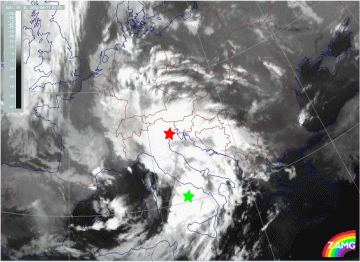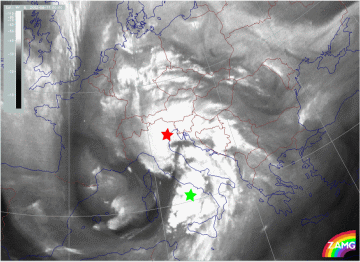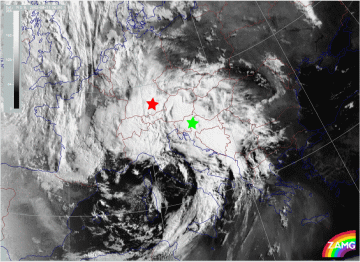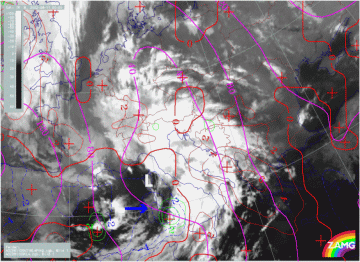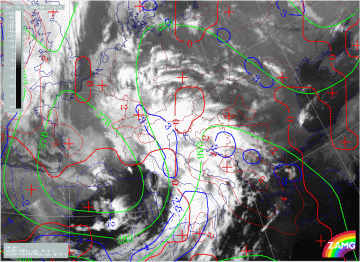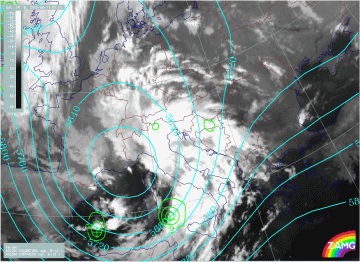Development from Wave into Occlusion stages
Cloud systems in the development phase: Wave into Occlusion
During the 11th of August Mediterranean lows develop and then develop further into an Occlusion cloud spiral: This can easily be seen in the satellite image loops (IR, WV and VIS); once again, several processes at meso- and synoptic-scale can be identified.
|
11 August 2002/00.00 UTC - Meteosat IR image; 00.00 - 18.00 UTC 3-hourly image Loop
|
|
There are several interesting cloud features and cloud developments ongoing in this time interval.
At 00.00 UTC there are two areas of interest:
- A cloud spiral over mid Italy (red star in loop above)
- A cloud intensification area over the Thyrrenian Sea (green star in loop above)
Up to 06.00 UTC the following processes can be observed:
- A NNE-ward shift of both systems:
- The cloud spiral over mid Italy developing into a large Occlusion spiral, extending N-ward over Bavaria, Switzerland and the W. Alps; cloudiness of this Occlusion spiral starts to decay in the second half of this phase (red star in loop above)
- The intensification area develops into a Wave bulge and then into a well developed cloud spiral, extending over SE-Austria, Slovenia and finally over the whole of Austria (green star in loop above).
At 12.00 UTC a new Wave - like bulge can be seen over Croatia which develops from a convective area, moves N-ward and further develops into a second circulation (low) at the Occlusion cloud band (yellow star in loop above).
|
11 August 2002/00.00 UTC - Meteosat WV image; 00.00 - 18.00 UTC 3-hourly image Loop
|
|
All features identified and described in the IR images are also very recognisable in the WV images:
- The cloud spiral (red stars) and the intensification area over mid Italy (green stars)
- A new wave and spiral development over Croatia (yellow stars)
In addition to the information from the IR images, pronounced Dark Stripes seen in the WV images, separate the cloud systems and indicate the different flow of dry air around the huge Upper Level Low.
|
11 August 2002/06.00 UTC - Meteosat VIS image; 06.00 - 17.00 UTC 3-hourly image Loop
|
|
From 06.00 UTC all features described in the IR images can also be seen well in the VIS images; the new Wave area developing over Croatia is seen in the VIS image only as an intensification area, but the 2nd low developing from this Wave within the Occlusion cloud band (18.00 UTC) can be identified very well.
Synoptic situation of the phase of development from Wave into Occlusion: relevant numerical parameters
In loops of imagery with relevant numerical parameters, such as frontal, Wave and upper level parameters for 11 August, the different processes detected in the cloud features are generally well supported by the model fields.
|
11 August 2002/00.00 UTC - Meteosat IR image; magenta: height contours 1000 hPa; green: positive vorticity afvection (PVA) 500 hPa,
red: temperature advection - WA 700 hPa; blue: temperature advection - CA 700 hPa; 00.00 - 18.00 UTC 6-hourly image Loop
|
|
As there are several Wave features recognisable in the satellite imagery during this phase, the analysis of these Waves together with the relevant model fields is of great interest:
At 00.00 UTC there are already some indications for a Wave over mid Italy in the model parameters:
- There is a very distinct bulge of WA and a CA maximum over the Thyrrenian Sea (behind the cloud spiral over mid Italy and the cloud intensification area.
- The PVA maximum, in the ideal case, following the rear of a Wave bulge, is shifted SW into the cloud intensification area.
At 06.00 UTC all parameters show a classical well developed Wave corresponding well with the cloud bulge. The main maximum of CA has slightly moved E (over S. Italy).
At 12.00 UTC, when a new Wave can be seen over Croatia, the model fields show some indications of a Wave. In particular, a small new bulge of CA protrudes to the NE.
Finally at 18.00 UTC the relevant Wave parameters are again well developed in the area of the 2nd low now appearing in the Occlusion cloud band. A separate maximum of CA which has deepened and split-off from the whole CA area is finally connected with the new 2nd low in the Occlusion cloud band.
|
11 August 2002/00.00 UTC - Meteosat IR image; blue: thermal front parameter (TFP) 500/1000 hPa, green: equivalent thickness 500/1000
hPa; red: temperature advection - WA 700 hPa, blue: temperature advection - CA 700 hPa; 00.00 - 18.00 UTC 6-hourly image Loop
|
|
Wave bulges are developing into Occlusion cloud bands. How do the relevant frontal parameters reflect this situation:
Generally speaking one can say that there are distinct frontal conditions in thickness, TFP and TA:
A zone of high gradient in thickness accompanies the Cold Front and there is a large ridge in the area of the Occlusion bands; the ridge becomes more pronounced with the development of the second Wave into an Occlusion cloud band; a secondary ridge might even be recognised within the main ridge.
While the TFP accompanies the thickness zone and Cold Front cloud bands close to the rear side very well, the Occlusion cloud band is not accompanied by a separate TFP in the area of the large thickness ridge. This might be a consequence of the extended ridge, where changes of gradients might be too small to exceed the threshold for the TFP.
The zero-line of TA is close to the cloud band, moving from the rear side of the system to the leading edge by the end of the case.
|
11 August 2002/00.00 UTC - Meteosat IR image; green: positive vorticity advection (PVA) 500 hPa, cyan: height contours 500 hPa; 00.00 -
18.00 UTC 6-hourly image Loop
|
|
There are distinct PVA maxima located to the rear of the Cold Front and Occlusion cloud bands. As there is a large low at upper levels (500 hPa), PVA is consequence of curvature and shear at this level.
At 300 hPa pronounced PVA maxima can also be distinguished, located at the rear of the Cold Front and Occlusion cloud bands. As there are also well developed jet streaks it cannot be determined if the PVA maxima are caused by shear or curvature. There is, however, a distinct connection between the PVA max in the left exit region of a huge jet streak and the 2nd low developing over Croatia, which then moves north-ward (12.00 - 18.00 UTC).
